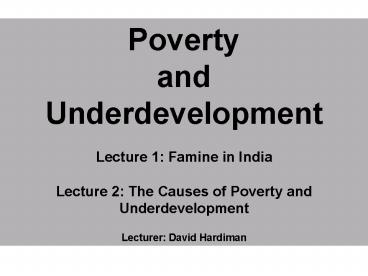Poverty - PowerPoint PPT Presentation
1 / 22
Title: Poverty
1
Poverty and Underdevelopment Lecture 1 Famine
in India Lecture 2 The Causes of
Poverty and Underdevelopment Lecturer David
Hardiman
2
Madras Famine 1876-77
3
Madras Famine 1876-77
4
Famine victims 1899-1900
5
Features of Famine in late Nineteenth Century
India 1. Rain failure. 2. Hoarding by traders
and urban moneylenders. Export of grain. 3.
Attacks on grain shops and stores. Upsurge in
robberies. 4. At normal harvest time,
Government demands tax. Many peasants refuse to
pay. Leads to coercion by tax-officials, forcing
richer peasants to pay up. Poorer peasants have
land confiscated, or mortgage or sell property -
jewellery, farm implements, land - to
moneylenders to pay taxes. Richest peasants and
moneylenders enlarge their holdings. 5.
Government establishes relief works, to which
poorest peasants go. Middling peasants, and
higher castes without resources starve. 6.
Destitute start to wander in search of food. Some
receive charitable relief in towns. 7.
Suicides, parents sell or kill children, deaths
(often of disease).
6
(No Transcript)
7
(No Transcript)
8
(No Transcript)
9
(No Transcript)
10
(No Transcript)
11
Major Famines in India 1860-1900 1860-61 -
western United Provinces. 1865-66 - Bengal,
Bihar, Orissa. Orissa worst hit. 1876-77 -
Maharashtra and South India. 1896-97 -
Maharashtra and South India 1899-1900 - Gujarat
and Rajasthan
12
British policy towards famine 1. Commitment
to free trade, following economic theory of Adam
Smith. 2. Belief that famine corrected
over-population, following theory of Thomas
Malthus. 3. Belief that free relief promotes
idleness and saps initiative, following doctrines
of the Utilitarians. People must labour for
their subsistence. 4. Famine-proofing through
building of irrigation canals 5. Famine Codes
drawn up in 1880, but only implemented
effectively after 1900.
13
Adam Smith
Adam Smith
14
British policy towards famine 1. Commitment
to free trade, following economic theory of Adam
Smith. 2. Belief that famine corrected
over-population, following theory of Thomas
Malthus. 3. Belief that free relief promotes
idleness and saps initiative, following doctrines
of the Utilitarians. People must labour for
their subsistence. 4. Famine-proofing through
building of irrigation canals 5. Famine Codes
drawn up in 1880, but only implemented
effectively after 1900.
15
Thomas Malthus
16
British policy towards famine 1. Commitment
to free trade, following economic theory of Adam
Smith. 2. Belief that famine corrected
over-population, following theory of Thomas
Malthus. 3. Belief that free relief promotes
idleness and saps initiative, following doctrines
of the Utilitarians. People must labour for
their subsistence. 4. Famine-proofing through
building of irrigation canals 5. Famine Codes
drawn up in 1880, but only implemented
effectively after 1900.
17
(No Transcript)
18
British policy towards famine 1. Commitment
to free trade, following economic theory of Adam
Smith. 2. Belief that famine corrected
over-population, following theory of Thomas
Malthus. 3. Belief that free relief promotes
idleness and saps initiative, following doctrines
of the Utilitarians. People must labour for
their subsistence. 4. Famine-proofing through
building of irrigation canals 5. Famine Codes
drawn up in 1880, but only implemented
effectively after 1900.
19
(No Transcript)
20
(No Transcript)
21
(No Transcript)
22
Bengal famine 1943

